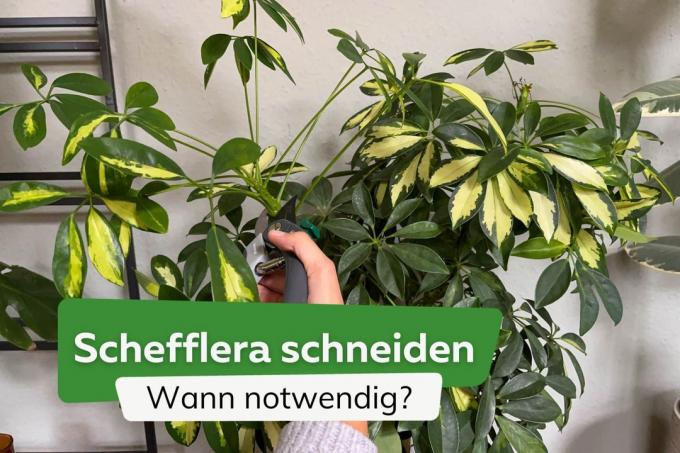
The Schefflera, also known as the Radiant Aralia, is a popular houseplant that you don't necessarily have to cut. Only a topiary cut is possible if the plant becomes too large.
To the point
- Reasons for pruning: Plant gets too big or is sick
- Single-shoot Scheffleraa can be trained to multi-shoot
- Diseased plant parts can be removed at any time
Table of contents
- Plant gets too big
- Plant is sick
- When not to cut
- frequently asked Questions
Plant gets too big
The Schefflera (Schefflera arboricola) is cut mainly because it is very fast-growing and spreads very widely, especially in height. It happens that the lower shoots of the plant become bald. In order to promote denser growth, the plant is occasionally shortened in height and cut into shape.

How to proceed:
- The best time for pruning is in spring, around March to May
- only use clean cutting tools
- Before cutting another plant, disinfect the scissors
- Shorten the plant to the desired size
- cut directly above a knot
- At this point the plant sprouts again
- The plant sprouts several times on each cut shoot
- Plant becomes bushier
- Remove unwanted shoots at the base
- Make sure that all shoots have enough space to grow
If the Schefflera is to grow as a single shoot, all other shoots must be removed regularly as soon as they become visible.
Plant is sick
Another reason for a cut is one Potted plant disease. Fungal diseases in particular come into question, where only pruning helps to stop the progression of the disease. If the plant needs to be cut because of an illness, it doesn't matter when it happens because it doesn't make sense to wait too long. All affected shoots are reduced to healthy tissue. The cuttings should then be disposed of in household waste and not in the compost.

The same applies if parts of the plant are infested with pests that cannot be easily removed.
When not to cut
Pruning should be avoided in weakened plants, as it is uncertain whether the plant will recover. If the plant leaves its leaves drooping, you should first look for the cause before cutting. If the plant suffers from wet roots, pruning can make the problem worse because the plant uses less water and evaporates. If the Schefflera sheds its leaves, it is often advisable to cut it back to encourage the plant to sprout again. But caution is also required here. You should always first look for the reason for the leaves falling off. Once the cause has been eliminated, the plant can be cut.
Possible reasons:
- Plant is too dark or too cool
- Substrate is too wet, root damage
- Drafts
frequently asked Questions
This is actually possible. However, care should be taken to ensure clean cut edges. The cutting may need to be cut again. It is then rooted in a glass with water or dipped in rooting powder and planted in potting soil.
The less leaf mass left after cutting, the less the houseplant needs to be watered after cutting. Fertilization is only carried out again when the plant shows new shoots. Be careful of too much sun, as this can dry out the plant at the cut edges.
Since the Schefflera only blooms very rarely when grown indoors, pruning it because of faded flowers hardly plays a role. If it does bloom, the flower spikes can simply be cut off after flowering.



